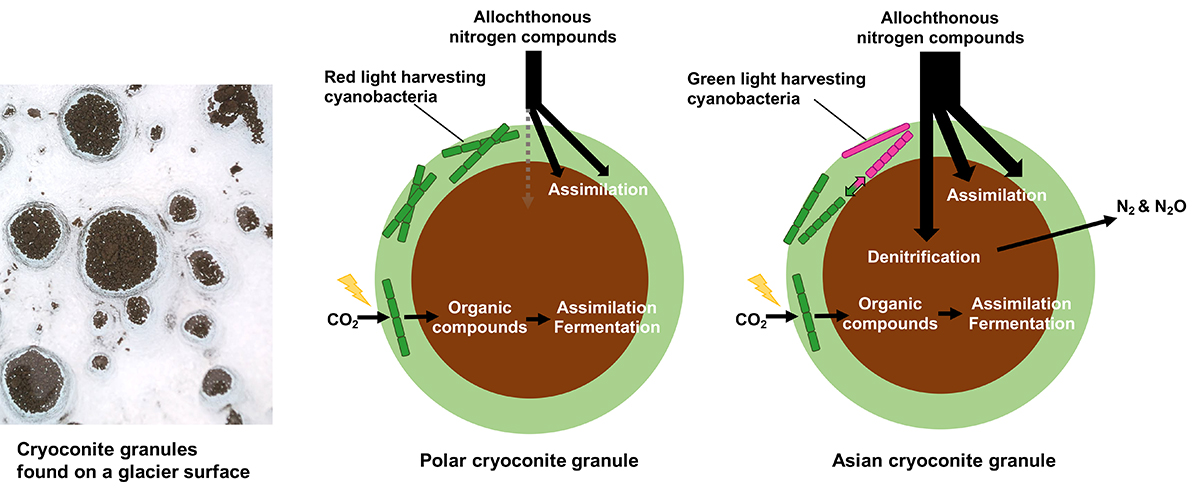Metagenomics reveals global-scale contrasts in nitrogen cycling and cyanobacterial light harvesting mechanisms in glacier cryoconite
Press release

Metagenomics reveals global-scale contrasts in nitrogen cycling and cyanobacterial light harvesting mechanisms in glacier cryoconite
T. Murakami, N. Takeuchi, H. Mori, Y. Hirose, A. Edwards, T. Irvine-Fynn, Z. Li, S. Ishii, T. Segawa
Microbiome (2022) 10, 50 DOI:10.1186/s40168-022-01238-7
![]() Press release (In Japanese only)
Press release (In Japanese only)
Background
Cryoconite granules are mineral–microbial aggregates found on glacier surfaces worldwide and are hotspots of biogeochemical reactions in glacier ecosystems. However, despite their importance within glacier ecosystems, the geographical diversity of taxonomic assemblages and metabolic potential of cryoconite communities around the globe remain unclear. In particular, the genomic content of cryoconite communities on Asia’s high mountain glaciers, which represent a substantial portion of Earth’s ice masses, has rarely been reported. Therefore, in this study, to elucidate the taxonomic and ecological diversities of cryoconite bacterial consortia on a global scale, we conducted shotgun metagenomic sequencing of cryoconite acquired from a range of geographical areas comprising Polar (Arctic and Antarctic) and Asian alpine regions.
Results
Our metagenomic data indicate that compositions of both bacterial taxa and functional genes are particularly distinctive for Asian cryoconite. Read abundance of the genes responsible for denitrification was significantly more abundant in Asian cryoconite than the Polar cryoconite, implying that denitrification is more enhanced in Asian glaciers. The taxonomic composition of Cyanobacteria, the key primary producers in cryoconite communities, also differs between the Polar and Asian samples. Analyses on the metagenome-assembled genomes and fluorescence emission spectra reveal that Asian cryoconite is dominated by multiple cyanobacterial lineages possessing phycoerythrin, a green light-harvesting component for photosynthesis. In contrast, Polar cryoconite is dominated by a single cyanobacterial species Phormidesmis priestleyi that does not possess phycoerythrin. These findings suggest that the assemblage of cryoconite bacterial communities respond to regional- or glacier-specific physicochemical conditions, such as the availability of nutrients (e.g., nitrate and dissolved organic carbon) and light (i.e., incident shortwave radiation).
Conclusions
Our genome-resolved metagenomics provides the first characterization of the taxonomic and metabolic diversities of cryoconite from contrasting geographical areas, highlighted by the distinct light-harvesting approaches of Cyanobacteria and nitrogen utilization between Polar and Asian cryoconite, and implies the existence of environmental controls on the assemblage of cryoconite communities. These findings deepen our understanding of the biodiversity and biogeochemical cycles of glacier ecosystems, which are susceptible to ongoing climate change and glacier decline, on a global scale.
Source: T. Murakami et al., Microbiome DOI:10.1186/s40168-022-01238-7
















